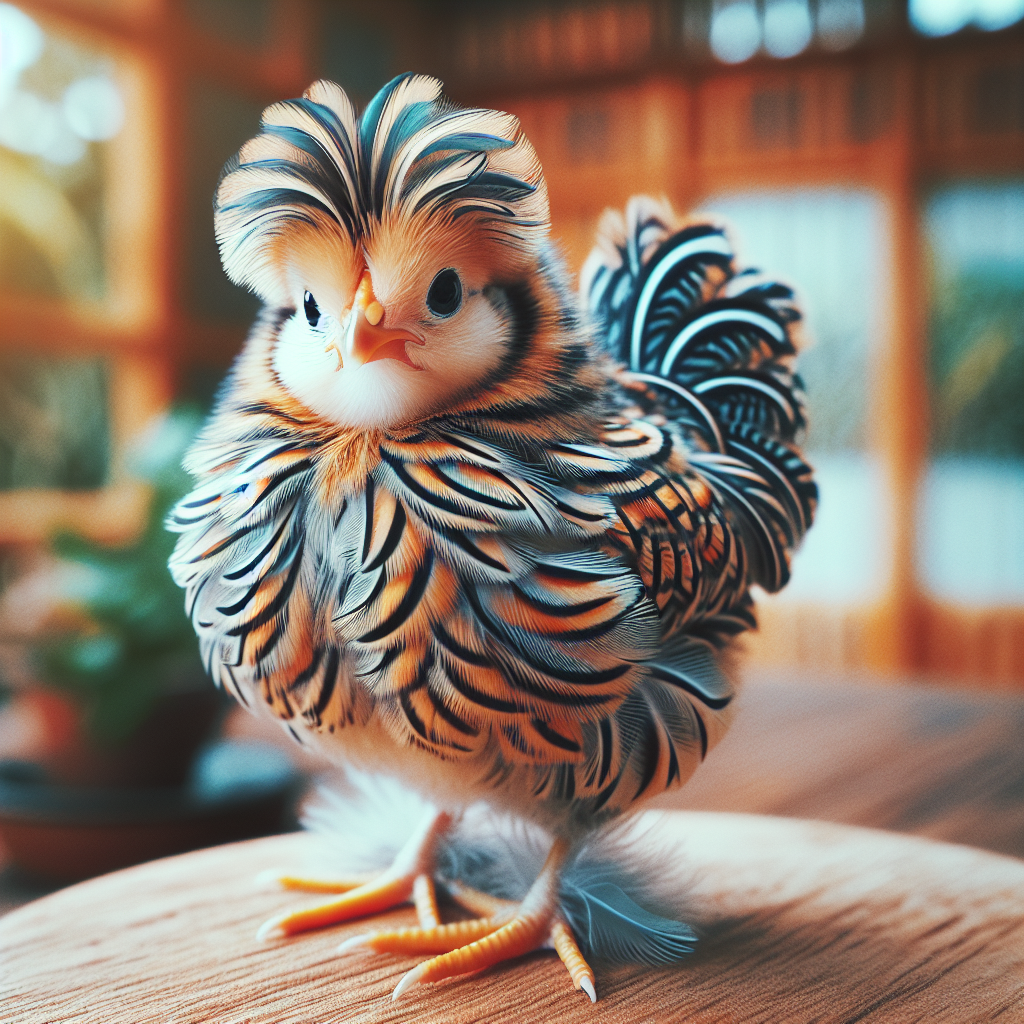In the world of poultry, there exists a captivating array of chicken breeds that are celebrated for their enchanting and distinctive vocalizations. These melodic creatures have garnered attention for their ability to produce a wide range of sounds that add a symphony of delight to anyone’s backyard. Whether it’s the energetic cackles of the Rhode Island Red or the soft and soothing clucks of the Silkies, each breed has its own melodious signature that contributes to the charm and allure of raising chickens. Get ready to embark on a journey of auditory delight as we uncover the fascinating sounds of various chicken breeds in this article.
Silkie
Description
Silkies are a unique breed of chicken known for their distinctive appearance and gentle nature. They have soft, fluffy feathers that are said to resemble silk or fur. Silkies have black skin and bones, and even their earlobes are black. They have five toes instead of the usual four, and their feathers lack barbicels, which gives them a silky appearance. Silkies are small in size and typically weigh around 2-4 pounds. They come in various colors, including white, black, blue, buff, and splash.
Vocalizations
Silkies are not particularly known for their vocalizations, as they tend to be quieter compared to other chicken breeds. However, they are not completely silent either. Silkies have a soft, melodic voice and are more likely to make cooing or purring sounds rather than loud crowing or squawking. Their gentle clucks and trills are a soothing addition to any flock.
Notable Sounds
One of the most distinctive sounds a Silkie makes is a “buck-wheat” call, which is a soft, high-pitched noise that resembles the syllables of its name. This sound is often associated with contentment and can often be heard when Silkies are happily foraging or enjoying their surroundings. Additionally, Silkies may also emit a surprised or alarmed chirp when they encounter something unexpected or perceive a potential threat.
Serama
Description
Serama chickens are the smallest breed of chicken in the world. Originating in Malaysia, they were bred specifically for their diminutive size and extravagant feather patterns. Seramas have a proud upright stance, with a prominent chest and short, compact bodies. They have beautifully patterned feathers with a wide range of colors and striking plumage. Despite their small size, Seramas are known for their confident and friendly nature, making them popular pets and show birds.
Vocalizations
Considering their tiny size, Seramas have a surprisingly loud and distinctive voice. They are quite talkative and enjoy participating in conversations with their human caretakers and fellow flock members. Seramas are known for their high-pitched crowing, which can be heard throughout the day. Their voices are loud and carry far, often surprising people with the powerful sound that comes from such a small bird.
Notable Sounds
One notable sound that Seramas make is their crowing, which sounds more like a tiny trumpet blast rather than the typical loud crows of larger chicken breeds. Their crowing can be quite frequent throughout the day, as they proudly announce their presence and assert their dominance. Seramas also have a unique alarm call, which is a rapid and urgent series of high-pitched chirps that they use to alert the flock about potential danger. This piercing sound can quickly gather the attention of other chickens and humans alike.
Sebright
Description
Sebright chickens are a bantam breed known for their captivating appearance and charming personality. They have a compact, round body and are often described as “pint-sized,” as they weigh only around 22-26 ounces. Sebrights have beautifully laced feathers, meaning the outer edges of their feathers are light while the centers are darker, creating a stunning effect. They come in two color variations: golden and silver. Sebrights are known for their friendly and docile nature, making them a popular choice for backyard flocks.
Vocalizations
Sebright chickens are generally quiet compared to some other breeds, but they still vocalize to communicate with each other and their human caregivers. They have a soft and gentle voice that complements their small size and delicate appearance. Sebrights are not particularly loud or boisterous, but they can occasionally let out a series of rapid clucks or low trills.
Notable Sounds
One of the notable sounds Sebrights make is a soft cooing noise, reminiscent of a gentle purr. This sound is often associated with contentment and can be heard when Sebrights are happily interacting with their flock members or when they are enjoying a comfortable spot in the sun. Sebrights may also make a soft trilling sound when exploring their environment or when excited by the presence of treats. Overall, their vocalizations may be more subtle compared to other breeds, but they are no less charming.
Polish
Description
Polish chickens, also known as Poland chickens, are a breed prized for their striking appearance and unique crested head feathers. They have a medium-sized body with compact proportions and a proud stance. Polish chickens come in various color variations, including white crested black, golden, silver, buff, and splash. The most defining feature of Polish chickens is their elaborate crests, which consist of feathers that grow forward instead of pointing backward like most other chickens. This gives them a distinctive “top hat” appearance. Polish chickens are known for their friendly and docile nature, making them a favorite among poultry enthusiasts.
Vocalizations
Polish chickens are known for being relatively quiet compared to some other breeds. They have a gentle and melodic voice that matches their graceful demeanor. Polish chickens are not prone to excessive squawking or crowing, making them suitable for urban or suburban settings where noise restrictions may be in place.
Notable Sounds
One of the notable sounds Polish chickens make is a soft, rhythmic clucking noise. This gentle clucking can often be heard when Polish chickens are content and relaxed, particularly when they find a comfortable spot for sunbathing or dust bathing. Polish chickens may also emit a soft trilling sound, similar to the purring of a cat, when they are particularly pleased or excited about something. While they may not be as vocal as some other breeds, Polish chickens certainly make their presence known through their gentle and harmonious songs.
Campine
Description
Campine chickens are a Belgian breed recognized for their elegant appearance and active nature. They have a slim and upright posture, with a long neck and well-developed chest. Campines have attractive, laced feathers that display a combination of light and dark shades, creating a beautiful contrast. They come in two color variations: silver and gold. Campines are naturally curious and energetic birds, and their agility makes them excellent foragers.
Vocalizations
Campine chickens are not particularly known for their vocalizations, as they tend to be a quieter breed. They are generally more focused on their activities and foraging pursuits than vocal communication. However, Campines still engage in soft clucks and trills to communicate with other flock members.
Notable Sounds
While Campines may not have distinct vocalizations, one notable sound they make is a soft and rapid clucking noise when they find something interesting while foraging. This noise can be heard when they discover a tasty treat, spot a potential predator, or encounter other stimuli that capture their attention. Additionally, when Campines are content and comfortable, they may emit a soothing trill, indicating their satisfaction with their surroundings. Campines may not be the loudest or most talkative chickens, but their occasional vocalizations are a delightful addition to any flock.
Houdan
Description
Houdan chickens are a French breed known for their unique appearance and striking crests of feathers. They have a round and compact body with a profusion of feathers on their heads, creating a distinctive “pompadour” hairstyle. Houdans have an abundance of fluffy feathers that cover their earlobes, giving them a fluffy appearance overall. They come in two color variations: white and mottled. Houdans have a calm and gentle temperament, making them suitable for both exhibition and backyard flocks alike.
Vocalizations
Houdan chickens are fairly quiet compared to some other breeds. They have a calm and serene voice that matches their composed nature. Houdans are not prone to excessive squawking or crowing, making them suitable for residential areas where noise restrictions may be in place.
Notable Sounds
One of the notable sounds that Houdan chickens make is a soft, rhythmic breathy clucking noise. This gentle clucking can often be heard when Houdans are content and relaxed, particularly when they are enjoying a dust bath or spending time with their flock members. Houdans may also emit a low, melodious hum when they are particularly content or enjoying a peaceful moment. While they may not be the most vocal of chicken breeds, Houdans certainly add a touch of tranquility to any flock with their soothing sounds.
Dutch Bantam
Description
Dutch Bantams, also known as Nederlandse Kriel, are a small and delightful breed of chicken. They have a compact and rounded body with a short neck and well-developed chest. Dutch Bantams come in various color variations, including black, white, silver, gold, and many more. One distinguishing feature of Dutch Bantams is their upright and proud stance, reflecting their lively and confident personality. Despite their small size, they have a bold and courageous nature.
Vocalizations
Dutch Bantams are not particularly known for being overly vocal. They are generally more focused on their activities and daily ventures than frequent vocal communication. However, this does not mean they are completely silent. Dutch Bantams engage in occasional soft clucks and chirps to communicate with other flock members or to express their satisfaction in their environment.
Notable Sounds
While Dutch Bantams may not be the chattiest of chicken breeds, they do have a notable sound that they make. When Dutch Bantams are pleased or excited, they may emit a soft, high-pitched trilling noise. This joyful trill can often be heard when they find a tasty treat or when they are happily exploring their surroundings. Dutch Bantams may not fill the air with constant chatter, but their occasional trills are a delightful reminder of their cheerful presence.
Japanese Bantam
Description
Japanese Bantams, also known as Chabo, are a breed of chicken that originated in Japan. They are small and compact, with a low stance and well-developed chest. Japanese Bantams come in a wide variety of elegant feather patterns and colors, adding to their aesthetic appeal. They have a calm and gentle temperament, making them excellent pets and show birds. Japanese Bantams are known for their striking appearance and friendly demeanor, making them a popular choice among poultry enthusiasts.
Vocalizations
Japanese Bantams are not particularly vocal compared to some other chicken breeds. They generally prefer to communicate through body language and subtle physical cues. However, they do engage in occasional soft clucks and chirps to communicate with their flock members or express their contentment.
Notable Sounds
While Japanese Bantams may not be the most talkative, they have a notable sound that they make. When Japanese Bantams are content and relaxed, they may emit a soft, melodic hum. This gentle hum is often associated with their peaceful nature and can be heard when they are enjoying the company of their flock or when they find a cozy spot to sunbathe. Japanese Bantams infuse a sense of tranquility into the atmosphere with their soothing hums, making them a cherished addition to any flock.
Frizzle
Description
Frizzle chickens are a unique and eye-catching breed known for their curly and twisted feathers. They have a medium-sized body with a compact and well-proportioned structure. Frizzles can come in various colors and patterns, including black, white, blue, and buff. What sets them apart from other breeds is their unusual feather structure. Frizzle feathers are twisted and curled, giving them a distinct and whimsical appearance. Frizzles are typically friendly and docile, making them popular pets for chicken enthusiasts.
Vocalizations
Frizzle chickens are not particularly known for their vocalizations. They are generally quiet compared to some other breeds, focusing more on their activities and interactions with their flock members. Frizzles have a calm and content voice that matches their peaceful demeanor.
Notable Sounds
Frizzles may not have distinct vocalizations, but they make their presence known through various sounds. One notable sound is a soft, low trill that they may emit when they are content and relaxed. This soothing trill can often be heard when Frizzles are happily perched or enjoying their surroundings. Additionally, Frizzles may occasionally make a soft purring noise, similar to that of a cat, when they are particularly pleased or comfortable. While Frizzles may not be the most vocal of chicken breeds, their gentle sounds add a touch of serenity to any flock.
Background and Importance of Unique Vocalizations in Chicken Breeds
Evolutionary Reasons
The unique vocalizations and sounds found in different chicken breeds serve various evolutionary purposes. Vocalizations are a means of communication and play a vital role in social dynamics within a flock. From attracting mates to establishing dominance or sounding alarm bells, chicken vocalizations are essential for their survival. These distinct vocalizations have developed over generations of selective breeding and natural adaptation, allowing different breeds to communicate effectively within their specific environments.
Communication and Social Dynamics
Chicken vocalizations play a crucial role in maintaining social harmony within a flock. Different sounds convey various messages, allowing chickens to communicate their needs, experiences, and emotions to their fellow flock members. Vocalizations also serve as a way to establish hierarchy and assert dominance, ensuring a well-structured social order within the flock. Additionally, unique vocalizations help chickens synchronize their behavior and coordinate activities, such as foraging or alerting each other to potential dangers.
In conclusion, chicken breeds are known for their unique vocalizations and sounds, each with their distinct characteristics and purposes. From the soft purring trills of Silkies to the powerful crowing of Seramas, these vocalizations reflect the diverse nature of chickens and their importance in communication and social dynamics within a flock. Understanding and appreciating these unique vocalizations adds depth to our understanding of these fascinating feathered creatures and enhances our bond with them as caregivers and enthusiasts. Embrace the symphony of chicken sounds and revel in the joy they bring to our lives.




